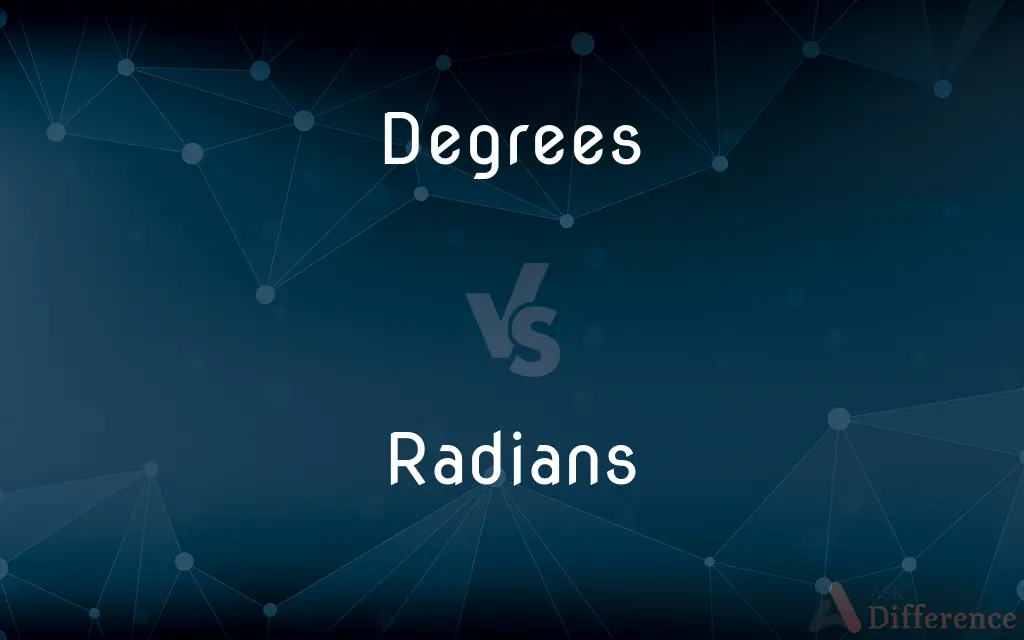Degrees vs. Radians — What's the Difference?
Edited by Tayyaba Rehman — By Fiza Rafique — Published on December 13, 2023
Degrees and Radians are units measuring angles; while there are 360° in a circle, there are 2π radians.

Difference Between Degrees and Radians
Table of Contents
ADVERTISEMENT
Key Differences
In the realm of mathematics and geometry, Degrees and Radians are standard units of measurement for angles. Degrees are perhaps the most commonly recognized, with a full circle being divided into 360 equal parts or degrees. Conversely, Radians offer a different perspective, basing the measurement on the radius of a circle, with a full circle equating to 2π radians.
Diving deeper, one might wonder why two units exist. Degrees have historical roots, with ancient civilizations like the Babylonians using a base-60 numbering system, which likely influenced the 360-degree circle. Radians, on the other hand, have a more intrinsic mathematical connection to circles, as the measurement relates directly to the circle's radius. One radian is the angle made when the length of a circle's arc equals its radius.
When performing mathematical calculations, especially in advanced mathematics and physics, the choice between Degrees and Radians can be crucial. For instance, in calculus, trigonometric functions like sine and cosine are often more naturally defined using Radians. However, in many everyday scenarios, such as navigation or simple geometry, Degrees remain the go-to choice due to their straightforward and intuitive nature.
Thus, understanding the relationship and distinction between these units is essential for accurate mathematical and scientific work.
Comparison Chart
Definition
Unit of angle based on dividing a circle into 360 parts
Unit of angle where the arc length is equal to the radius
ADVERTISEMENT
Relation to Circle
Full circle = 360°
Full circle = 2π radians
Origin
Historically based on Babylonian base-60 system
Directly related to a circle's radius
Use Cases
Common in everyday scenarios and basic geometry
Preferred in advanced math and physics
Compare with Definitions
Degrees
Units of measure for angles based on dividing a circle into 360 parts.
A right angle is 90 Degrees.
Radians
The standard unit of angular measure in mathematics.
Trigonometric functions in calculus often use Radians.
Degrees
A division of a circle commonly used in navigation and geometry.
The Earth rotates 360 Degrees in 24 hours.
Radians
A measure of an angle where the arc's length equals the circle's radius.
An angle of 1 Radian is subtended by an arc equal in length to the radius.
Degrees
A unit that can be subdivided into minutes and seconds.
GPS coordinates might provide longitude and latitude in Degrees, minutes, and seconds.
Radians
A unit that relates directly to the properties of a circle.
There are 2π Radians in a full circle.
Degrees
An ancient unit for measuring angles.
The protractor measures angles in Degrees.
Radians
A more intrinsic way to measure angles compared to degrees.
The sine of an angle in Radians has a power series representation.
Degrees
One of a series of steps in a process, course, or progression; a stage
Proceeded to the next degree of difficulty.
Radians
Often used in physics, especially in rotational dynamics.
Angular velocity is typically measured in Radians per second.
Degrees
A step in a direct hereditary line of descent or ascent
First cousins are two degrees from their common ancestor.
Radians
A unit of angular measure equal to the angle subtended at the center of a circle by an arc equal in length to the radius of the circle, approximately 57°17′44.6".
Degrees
Relative social or official rank, dignity, or position.
Radians
Plural of radian
Degrees
Relative intensity or amount, as of a quality or attribute
A high degree of accuracy.
Degrees
The extent or measure of a state of being, an action, or a relation
Modernized their facilities to a large degree.
Degrees
A unit division of a temperature scale.
Degrees
(Mathematics) A planar unit of angular measure equal in magnitude to 1/360 of a complete revolution.
Degrees
A unit of latitude or longitude, equal to 1/360 of a great circle.
Degrees
The greatest sum of the exponents of the variables in a term of a polynomial or polynomial equation.
Degrees
The exponent of the derivative of highest order in a differential equation in standard form.
Degrees
An academic title given by a college or university to a student who has completed a course of study
Received the Bachelor of Arts degree at commencement.
Degrees
A similar title conferred as an honorary distinction.
Degrees
(Law) A division or classification of a specific crime according to its seriousness
Murder in the second degree.
Degrees
A classification of the severity of an injury, especially a burn
A third-degree burn.
Degrees
(Grammar) One of the forms used in the comparison of adjectives and adverbs. For example, tall is the positive degree, taller the comparative degree, and tallest the superlative degree of the adjective tall.
Degrees
One of the seven notes of a diatonic scale.
Degrees
A space or line of the staff.
Degrees
Plural of degree
Degrees
A standardized way to quantify turns or rotations.
The hands of a clock move 30 Degrees every hour.
Common Curiosities
Is one unit more "accurate" than the other?
Both Degrees and Radians can measure angles accurately; it's the context that dictates which is more suitable.
How many Radians make up a complete circle?
A full circle consists of 2π Radians.
When might one prefer to use Radians over Degrees?
In advanced mathematics, physics, and engineering, Radians are often preferred.
Why do we have both Degrees and Radians as units?
Degrees are historically rooted and intuitive, while Radians have a direct mathematical connection to circles.
Can Degrees be broken down into smaller units?
Yes, Degrees can be subdivided into minutes and seconds.
How many Degrees are in a full circle?
A full circle has 360 Degrees.
How does the concept of Radians link to the circle's radius?
One Radian is the angle created when a circle's arc length matches its radius.
Which unit is more prevalent in trigonometric functions?
In advanced math, trigonometric functions often use Radians.
What is the significance of π in Radians?
π Radians represents half a circle or 180 Degrees.
Do all circles, irrespective of their size, have 2π Radians?
Yes, every circle, regardless of its diameter, has 2π Radians.
Are protractors typically marked in Degrees or Radians?
Protractors are typically marked in Degrees.
How is the concept of Radians derived?
Radians are based on the idea that an angle's measure is the arc length subtended divided by the circle's radius.
In what scenarios might one encounter Radians outside of academic settings?
In physics, especially rotational dynamics, and some engineering contexts, Radians are commonly used.
When were Degrees first introduced as a measure?
Degrees have ancient roots, with influences from Babylonian base-60 systems.
Share Your Discovery

Previous Comparison
Purees vs. Smoothies
Next Comparison
Fishes vs. SharksAuthor Spotlight
Written by
Fiza RafiqueFiza Rafique is a skilled content writer at AskDifference.com, where she meticulously refines and enhances written pieces. Drawing from her vast editorial expertise, Fiza ensures clarity, accuracy, and precision in every article. Passionate about language, she continually seeks to elevate the quality of content for readers worldwide.
Edited by
Tayyaba RehmanTayyaba Rehman is a distinguished writer, currently serving as a primary contributor to askdifference.com. As a researcher in semantics and etymology, Tayyaba's passion for the complexity of languages and their distinctions has found a perfect home on the platform. Tayyaba delves into the intricacies of language, distinguishing between commonly confused words and phrases, thereby providing clarity for readers worldwide.












































